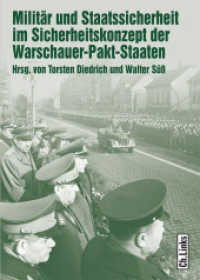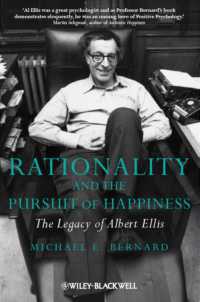- ホーム
- > 洋書
- > 英文書
- > Psychology
Full Description
Cognitive Archaeology is a relatively young though fast growing discipline. The intellectual heart of cognitive archaeology is archaeology, the discipline that investigates the only direct evidence of the actions and decisions of prehistoric people. Its theories and methods are an eclectic mix of psychological, neuroscientific, paleoneurological, philosophical, anthropological, ethnographic, comparative, aesthetic, and experimental theories, methods, and models, united only by their focus on cognition.
The Oxford Handbook of Cognitive Archaeology is a landmark publication, showcasing the theories, methods, and accomplishments of archaeologists who investigate the human mind, including its evolutionary development, its ideation (thoughts and beliefs), and its very nature-through material forms. The volume encompasses the wide spectrum of the discipline, showcasing contributions from more than 50 established and emerging scholars from Europe, Africa, Asia, Australia, and the Americas. Prominent among these are contributions that discuss the epistemological frameworks of both the evolutionary and ideational approaches and the leading theories that ground interpretations. Significantly, the majority of chapters deliver substantive contributions that analyze specific examples of material culture, from the oldest known stone tools to ceramic and rock art traditions of the recent millennium. These examples include the gamut of methods and techniques, including typology, replication studies, chaînes operatoires, neuroarchaeology, ethnographic comparison, and the direct historical approach.
In addition, the book begins with retrospective essays by several of the pioneers of cognitive archaeology, presenting a broad range of state-of-the-art investigations into cognitive abilities, tackling thorny issues like the cognitive status of Neandertals, and concluding with speculative essays about the future of an archaeology of mind, and of the mind itself.
Contents
1: The archaeology of mind-Past, present, and future
2: Ideas of cognitive evolution in the making
3: Rock art and cognitive archaeology: A personal Southern African journey
4: Redescribing the Oldowan
5: Insights into the cognitive abilities of Oldowan and Acheulean hominins: Experimental approaches
6: The expert Neandertal mind and brain, revisited
7: What is cognitive archaeology? The material engagement approach
8: From technical reasoning to cumulative technological culture
9: Evolutionary neuroarchaeology
10: More than the sum of their parts? Networks as methods and as heuristics in cognitive archaeology
11: Towards an ecology of evolving skills
12: The evolution of human causal cognition
13: On the problem of the interpretation of symbols and symbolism in archaeology
14: Investigating cognitive abilities of early humans: The Windows Approach
15: Thinking, for example in and about the past: Approaches to ideational cognitive archaeology
16: Methods in neuroarchaeology
17: Experimental archaeology enables inferences about human cognition
18: Prehistoric numeracy: Approaches, assumptions, and issues
19: Systematically reconstructing behavioral architectures as a basis for cognitive archaeology
20: Tool use by New Caledonian crows can inform cognitive archaeology: A case study using Observational Action Coding
21: A Pleistocene record of making symbols
22: The cultural ecology of fear: Human funerary cognition in evolutionary perspective
23: Current conceptions of human cognition in understanding the origins of human art
24: The relevance of geometry to understanding human evolution from the perspective of cognitive domains and the Neurovisual Resonance Theory
25: The deep history of musicality: Evolutionary cognitive archaeology and music
26: The neuro-archaeology of language origins
27: Where are the children? Archaeological evidence of children in the hunter-gatherer societies of the Upper European Paleolithic








